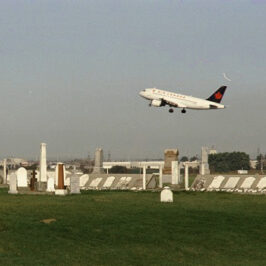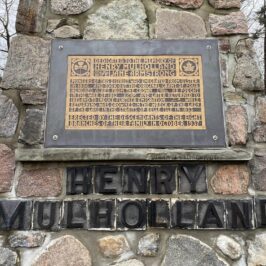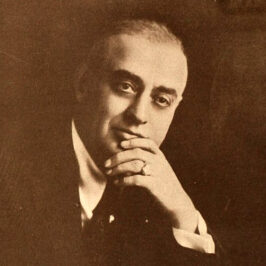Today we look at Oakham House at 63 Gould Street in Toronto. Over its 176 years it has had many incarnations – a home and office, Working Boys Home, university residence and social centre with a pub and café.
Located at the southwest corner of Church and Gould, Oakham House was built in 1848 by architect William Thomas as his own home and office. It is considered one of the best examples of domestic Gothic Revival architecture in Toronto. William Thomas had been born in Suffolk, England and lived for some time in Leamington, Warwickshire where he designed the curving Lansdown Crescent and Circus at Leamington Spa. With relatives in nearby Oakham, Rutland it is believed that William was probably familiar with Oakham Castle and that may have influenced the choice for the name of his Toronto home. William and his wife Martha Tutin came to Canada in 1843 with their five sons and five daughters.
In Canada, in addition to Oakham House, William Thomas is credited with many projects including St. Michael’s Cathedral in Toronto, the Niagara District Court House and Town Hall in Niagara-on-the-Lake, St. Lawrence Hall in Toronto, Old City Hall in Guelph, Brock’s Monument in Queenston Heights, St. Paul’s Presbyterian Church in Hamilton, the New Quebec Customs House in Quebec City, the Halifax Old County Courthouse in Nova Scotia and the Don Jail in Toronto.
In 1860, shortly before his death, Thomas sold the home to John McGee, owner of the Phoenix Foundry and no relation to Thomas D’Arcy McGee, whose family lived here until 1892. For a short time, from 1893 to 1899, Harriet Muirhead lived here and operated it as a boarding house from 1895 on. In 1899 it was purchased by the Society for Working Boys and at this time became the “Home for Working Boys”, with an addition (new wing) and renovations (rooms cuts into cubicles) completed in 1900 by architect David Brash Dick. Thomas’ original office in the wing on Gould Street was replaced by this addition.
In 1901, here is where we find my personal interest and connection to this beautiful heritage building. My great-great aunt Florence Lightwood is listed here as a 22-year-old lodger, one of three women with the occupation “Laundry”. The superintendent of the Working Boys Home was Simon Smith and there were 43 “inmates”. The inmates are not listed in the census, which was an unfortunate common practice, but one of them was very likely my great-grandfather George who had been sent to Canada in 1897 with his younger brother Frank (Francis) as British Home Children, part of a Dr. Barnardo’s group, after their father’s death in 1896.
In 1899, Florence along with their mother Annie Rosa and younger siblings Henrietta and Alfred came to Canada with the support of Dr. Barnardo’s, and in July 1900 were reunited with the two boys, who were sent down to Toronto from the farms they had been working on in Muskoka, when their mother proved she could care for them. In May 1900 Annie Rosa attained work as a cook at the soon to close Newsboys’ Lodging and Industrial Home (incorrectly referred to as the Working Boys Home in Barnardo documents) on Frederick Street and by July 1900 had secured employment as a seamstress with lodging for herself and the two youngest children at the Protestant Working Home at 344 Dovercourt; this is where she was able to take in George and Frank that month. Like the Working Boys Home, none of the 190 inmates here were listed in the 1901 census but we know that the youngest Lightwood children were certainly among them. Florence secured employment at the new Working Boys Home on Gould Street and sister Lillian, who had been employed in service in England, was finally able to come over and join the family in 1901.
And so it was, in its very early days as a Working Boys Home, that my great-great aunt Flo did laundry for the staff and inmates of Oakham House. Were George and/or Frank inmates? Very likely. If not, they were inmates of a larger but similar institution on the other side of town. The adults worked to save money and provide a good start for the younger children, away from the challenging conditions they had faced in England after the death of father Francis. All lived with hopes that they would be released from care and the family could start their new lives in Canada together, which I am proud to say they did achieve. In 1908, with George gainfully employed at the Toronto Photo Engraving Company at 81 Mutual Street, Barnardo’s closed his file.
I feel the pull of ghosts – not spirits per se, but whispers of the past and a tangible connection to our family’s start in Toronto, whenever I pass by Oakham House.
After serving as the Working Boys Home for almost 60 years, the Ontario government bought the house in 1958 and gave it to the Ryerson Institute of Technology. They renamed the building Kerr Hall, after its President Howard Kerr. The building was renovated, again, and reopened in 1960 with space for male residents on the upper floors. The basement housed student organization offices, a conference room, and a tuck shop. Not long after, with a new Kerr Hall under construction, the build was renamed Eric Palin Hall in 1969, after the founder of the School of Electronics and Radio and the School of Television Arts.
Palin Hall remained a residence and social centre for the Polytechnic Institute until 1973 when the Fire Department declared the second and third floors unsafe to live in. The rest of building remained open with dining facilities, lounges, games, and meeting rooms. In 1976, the building underwent renovations yet again, this time by George Kneider Architects, and reopened in 1978 with a pub on the lower lever and its original name of Oakham House restored. In 2021, another renovation project expanded the kitchen space with an upgraded cafe. In 2022 Ryerson University became Toronto Metropolitan University and that is how we find it today.
On the Church Street side, the name “Oakham House” had once been carved in stone on a sign was mounted above the front door. Two iron dogs with iron rings in their mouths for hitching horses, which had been cast at John McGee’s Phoenix Foundry, were originally set at the curb of the house. They were originally painted red to represent Chesapeake Bay Retrievers. At some point, after the use of horses in the city went by the wayside, the dogs were removed from the curb, the rings removed, and mounted on the front entrance near the steps and were repainted black. Both the dogs and the “Oakham House” sign have been removed. I don’t know where the sign went but the two dogs can apparently be found in Archives and Special Collections reading room on the fourth floor of the university library. And with close inspection, you can still faintly make out the ghost sign of “Oakham House” above the Church Street doorway. A designated heritage building since 1978, the Toronto Historical Board mounted a plaque on a rock outside the building in 1977 which has since been removed. In 2023 Heritage Toronto mounted a new historic plaque beside the entrance at 63 Gould Street.





Leave a Reply